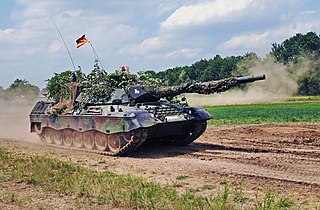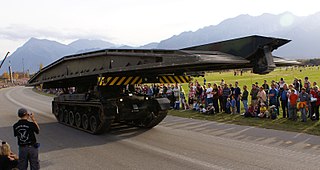
The Kampfpanzer Leopard is a main battle tank designed by Porsche and manufactured by Krauss-Maffei in West Germany, first entering service in 1965. Developed in an era when HEAT warheads were thought to make conventional heavy armour of limited value, the Leopard design focused on effective firepower and mobility instead of heavy protection. It featured moderate armour, only effective against low caliber autocannons and heavy machine guns, giving it a high power-to-weight ratio. This, coupled with a modern suspension and drivetrain, gave the Leopard superior mobility and cross-country performance compared to most other main battle tanks of the era, only being rivaled by the French AMX-30 and Swedish Strv 103. The main armament of the Leopard consisted of a German license-built version of the British Royal Ordnance L7 105 mm rifled gun, one of the most effective and widespread tank guns of the era.

The Panzerkampfwagen IV, commonly known as the Panzer IV, is a German medium tank developed in the late 1930s and used extensively during the Second World War. Its ordnance inventory designation was Sd.Kfz. 161.

This article lists production figures for German armored fighting vehicles during the World War II era. Vehicles include tanks, self-propelled artillery, assault guns and tank destroyers.

The Panzerkampfwagen 38(t), originally known as the ČKD LT vz. 38, was a tank designed during the 1930s, which saw extensive service during World War II. Developed in Czechoslovakia by ČKD, the type was adopted by Nazi Germany following the annexation of Czechoslovakia. With the German Army and other Axis forces, the type saw service in the invasions of Poland, France and the USSR. Production ended in 1942, when its main armament was deemed inadequate. In all, over 1,400 Pz. 38(t)s were manufactured. The chassis of the Pz. 38(t) continued to be produced for the Marder III (1942–1944) with some of its components used in the later Jagdpanzer 38 (1944–1945) tank destroyer and its derivative vehicles.

The Panther tank, officially Panzerkampfwagen V Panther with ordnance inventory designation: Sd.Kfz. 171, is a German medium tank of World War II. It was used on the Eastern and Western Fronts from mid-1943 to the end of the war in May 1945.

The Leopard 2 is a third generation German main battle tank (MBT). Developed by Krauss-Maffei in the 1970s, the tank entered service in 1979 and replaced the earlier Leopard 1 as the main battle tank of the West German army. Various iterations of the Leopard 2 continue to be operated by the armed forces of Germany, as well as 13 other European countries, and several non-European countries, including Canada, Chile, Indonesia, and Singapore. Some operating countries have licensed the Leopard 2 design for local production and domestic development.

The Schützenpanzer Marder 1 is a tracked German infantry fighting vehicle designed for use with the West German Panzergrenadiere units, mechanized infantry specialized for IFV combat. It has been operated by the German Army as the main Panzergrenadiere IFV since the 1970s through to the present day. Developed as part of the rebuilding of West Germany's armoured fighting vehicle industry, the Marder has proven to be a successful and solid infantry fighting vehicle design.

The 7.5 mm Maschinengewehr 1951 or Mg 51 is a general-purpose machine gun manufactured by W+F of Switzerland. The weapon was introduced into Swiss service when the Swiss Army initiated a competition for a new service machine gun to replace the MG 11 heavy machine gun and the Furrer M25 light machine gun adopted in 1911 and 1925 respectively.

The Panzer 61 was a Swiss Cold War era medium tank later reclassified as a second-generation main battle tank. The tank had a weight of 36.5 tons and was powered by a 630 hp diesel engine, which gave it a top road speed of 50 km/h (31 mph). The primary armament of the Panzer 61 was a 105 mm main gun.

This article deals with the tanks serving in the German Army throughout history, such as the World War I tanks of the Imperial German Army, the interwar and World War II tanks of the Nazi German Wehrmacht, the Cold War tanks of the West German and East German Armies, all the way to the present day tanks of the Bundeswehr.

The Entpannungspanzer 65 is a Swiss armored recovery vehicle developed by Eidgenoessische Konstruktionswerkstaette Thun in the late 1960s. The vehicle served as a traveling workshop for the Swiss military.

The Brückenpanzer 68 is an armoured vehicle-launched bridge manufactured by the Eidgenoessische Konstruktionswerkstaette, which was used by the Swiss Army. It is the bridge-laying version of the Panzer 68 tank.

Fliegerabwehrpanzer 68 was a Swiss self-propelled anti-aircraft gun which was tested but did not enter service.

The Mittlerer Panzer 1958 or Panzer 58 was a medium tank of Swiss design. Twelve tanks were produced and later converted to Panzer 61s.

Eidgenössische Konstruktionswerkstätte English: "Federal Constructions Works", short K+W, was a Swiss state-owned enterprise, with the aim of making the Swiss military independent of foreign sources for its equipment needs. It was established in 1867 in Thun and produced artillery, vehicles and other typical military equipment. In 1914 Switzerland put in an effort to make itself independent of foreign suppliers of military aircraft and started the production of the DH-1 in Thun. Long-standing connections to the ETH Zurich ensured the necessary know-how. 1940 the aviation department moved from Thun to Emmen (LU) and in 1943 it became a separate unit of the Swiss Armed Forces independent under the name of Eidgenössisches Flugzeugwerk (F+W). The Eidgenoessische Konstruktionswerkstaette focused now on the production of armoured fighting vehicles for the Swiss Army, both of its own designs and licensed production of M113 armored personnel carriers and Leopard 2 tanks and other land systems for the Swiss Army. Since 1995 it changed its name several times, started exporting and is now part of RUAG Defence.

The Centurion ARV Mk II, was a British armoured recovery vehicle based on the Centurion main battle tank.
The Panzer 2000 was a Swiss tank planned to replace the Panzer 68, produced by Eidgenoessische Konstruktionswerkstaette. It was intended for use by the Swiss Armed Forces.

The M109, a widely-used American howitzer, has been operated by the Swiss Armed Forces since 1971. Under Swiss operation, the M109 has received numerous modernisations, though it is gradually being phased out of service, as its service life is approaching its end.






















